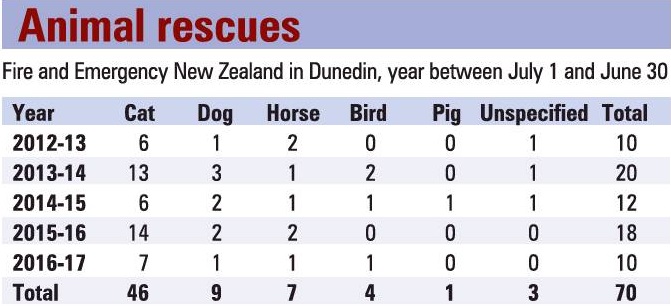
Mostly cats but also dogs, horses and birds feature among animals Dunedin firefighters have been deployed to rescue in the past five years.
An Official Information Act request revealed firefighters in Dunedin were called to rescue 70 animals between July 1, 2012 and June 30, 2017.
Of the 17 stations in the wider Dunedin area, 10 stations had responded to incidents relating to an animal rescue, the request revealed.
Fire and Emergency New Zealand Senior Station Officer Ben Pitelen, of Dunedin City Station, was not surprised cats accounted for about 65% of animal rescue callouts in Dunedin.
Firefighters were frequently called to rescue cats ‘‘stuck’’ in trees or on roofs, he said.
More often than not, however, a cat would get down without assistance.

‘‘They will come down — have you ever seen a cat skeleton up a tree?’’
In most cases, the owner of the cat was more concerned than the pet, he said.
If a cat was up a power pole, the electricity distribution company needed to be contacted to switch off the power before a rescue could be attempted, he said.
The welfare of firefighters had to be considered when assessing an animal rescue, as cats often scratched and dogs could bite, he said.
‘‘A dog will have a go at you because he’s scared.’’
A firefighter would often secure the ladder and give the owner the chance to retrieve their pet.
Rescuing horses was often difficult.
If a horse had slipped down a bank and fallen on its side, a crew could help it back on its feet, but if a horse got ‘‘bogged’’ in a paddock, it was a ‘‘nightmare’’ to rescue.
The horse’s hooves became ‘‘suctioned’’ in the mud.
‘‘You can have 12 firemen there and you won’t budge it.’’
A digger could be used to assist with extracting the animal but it was hard to judge how much pressure could be applied without injuring it.
Among birds, seagulls were the most frequently in need of rescue.
In one instance, a seagull swallowed a fishing hook and the line attached to it got wrapped around a flagpole in Cumberland St.
A crew had to scale the building to free the bird, he said.
If a bird got stuck in a wall cavity, the crew had to get permission from the property owner before they could begin to rip cladding off.
‘‘We can’t just go rip, s... and bust.’’












